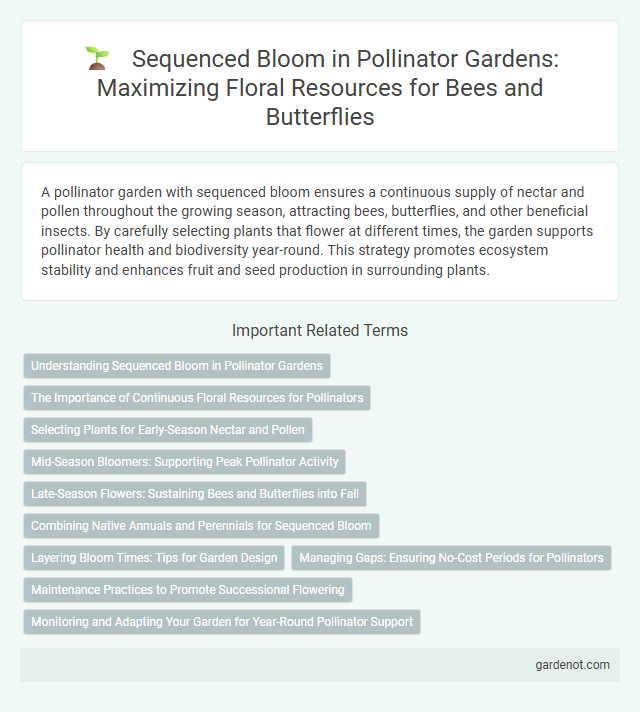A pollinator garden with sequenced bloom ensures a continuous supply of nectar and pollen throughout the growing season, attracting bees, butterflies, and other beneficial insects. By carefully selecting plants that flower at different times, the garden supports pollinator health and biodiversity year-round. This strategy promotes ecosystem stability and enhances fruit and seed production in surrounding plants.
Understanding Sequenced Bloom in Pollinator Gardens
Sequenced bloom in pollinator gardens ensures continuous floral resources throughout the growing season by carefully selecting and planting species with staggered flowering times. This strategy supports diverse pollinator populations, including bees, butterflies, and hummingbirds, by providing consistent nectar and pollen sources. Understanding and implementing sequenced bloom enhances garden biodiversity and promotes effective pollination for local ecosystems.
The Importance of Continuous Floral Resources for Pollinators
Sequenced bloom in a pollinator garden provides continuous floral resources essential for sustaining diverse pollinator populations throughout the growing season. Continuous availability of nectar and pollen supports the life cycles of bees, butterflies, and other pollinators, promoting healthy ecosystems and enhancing crop pollination. Incorporating native plants with staggered flowering periods ensures year-round forage, improving pollinator resilience and biodiversity.
Selecting Plants for Early-Season Nectar and Pollen
Selecting plants that bloom sequentially throughout the season ensures a continuous supply of nectar and pollen for pollinators in a pollinator garden. Early-season bloomers such as crocus, snowdrops, and willow provide critical resources during late winter and early spring when pollinators emerge from dormancy. Incorporating native species like willows (Salix spp.), maples (Acer spp.), and early-flowering wildflowers supports diverse pollinator species and strengthens ecosystem resilience.
Mid-Season Bloomers: Supporting Peak Pollinator Activity
Mid-season bloomers such as Echinacea, Monarda, and Rudbeckia provide abundant nectar and pollen during peak pollinator activity from late spring to early summer. These plants are essential for sustaining bees, butterflies, and hummingbirds by offering continuous floral resources when pollinator demand is highest. Incorporating diverse mid-season species in a pollinator garden enhances habitat connectivity and supports pollinator health and biodiversity.
Late-Season Flowers: Sustaining Bees and Butterflies into Fall
Late-season flowers such as asters, goldenrods, and sunflowers are crucial for sustaining bee and butterfly populations into the fall by providing essential nectar and pollen sources when early-season blooms fade. These plants extend the foraging period, supporting pollinators' energy needs for reproduction and migration. Incorporating a diverse mix of native late-blooming species in pollinator gardens ensures continuous habitat and food availability during critical seasonal transitions.
Combining Native Annuals and Perennials for Sequenced Bloom
Combining native annuals and perennials in a pollinator garden ensures a sequenced bloom that supports pollinators throughout the growing season. Native perennials provide a reliable foundation with staggered flowering times, while annuals fill gaps with vibrant, short-lived blooms that attract diverse pollinators. This strategic planting maximizes nectar and pollen availability from early spring to late fall, enhancing pollinator health and biodiversity.
Layering Bloom Times: Tips for Garden Design
Layering bloom times in a pollinator garden ensures continuous nectar and pollen sources throughout the growing season, attracting diverse pollinators like bees, butterflies, and hummingbirds. Selecting early-blooming species such as crocus and snowdrops, mid-season plants like coneflowers and milkweed, and late bloomers like goldenrod creates a dynamic, thriving habitat. Proper sequencing not only supports pollinator health but also enhances garden aesthetics with vibrant, overlapping floral displays from spring through fall.
Managing Gaps: Ensuring No-Cost Periods for Pollinators
Sequenced bloom planning in pollinator gardens helps manage gaps by strategically selecting a variety of native plants that flower sequentially throughout the growing season. This approach ensures continuous nectar and pollen availability, preventing no-cost periods that could stress pollinators such as bees, butterflies, and hummingbirds. Effective gap management supports sustainable pollinator populations while enhancing biodiversity and ecosystem resilience.
Maintenance Practices to Promote Successional Flowering
Implementing sequenced bloom through targeted maintenance practices enhances pollinator gardens by ensuring continuous floral resources throughout the growing season. Regular deadheading, strategic pruning, and staggered planting schedules promote successional flowering, sustaining nectar and pollen availability for diverse pollinator species. Soil health management and adaptive watering techniques further support prolonged bloom cycles critical for ecosystem resilience.
Monitoring and Adapting Your Garden for Year-Round Pollinator Support
Sequenced bloom in a pollinator garden ensures continuous nectar and pollen availability by planting species with staggered flowering periods from early spring to late fall. Monitoring bloom times and pollinator activity helps identify gaps in floral resources, allowing timely adjustments such as introducing new plant varieties or extending flowering seasons. Adapting the garden based on seasonal data supports diverse pollinator species, promoting ecosystem resilience and biodiversity throughout the year.
Sequenced bloom Infographic

 gardenot.com
gardenot.com